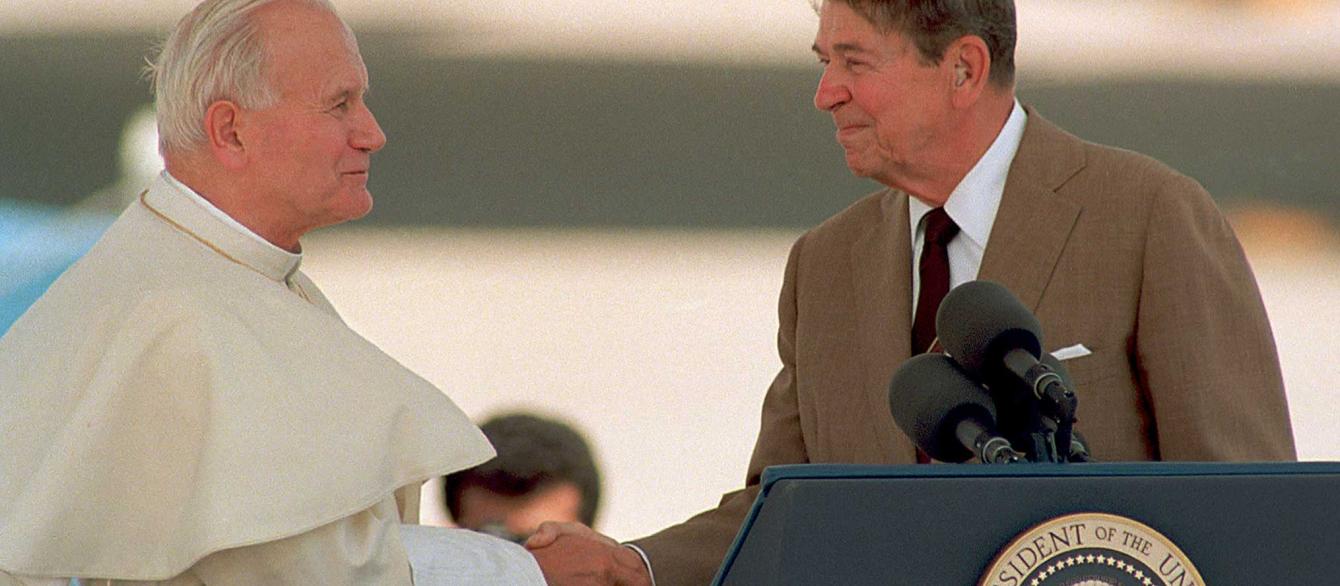By the summer of 1947, the United States found itself in an unprecedented position: it was engaged in its first-ever holy war. Locked in an ideological conflict and arms race with the godless Soviets, the Truman administration sought to galvanize support by framing the nascent Cold War as a sort of Armageddon in which the US represented and protected the interests of adherents of all faith traditions, while the USSR threatened each without distinction.
The looming shadow of nuclear weapons added yet another theological dimension to this tumult. With this technology in the mix, the threat expanded from conventional war to apocalypse. Perhaps as an obvious consequence, the Vatican was enticed to join the discourse. Examining the role of the Vatican in nuclear history provides a lens for understanding the evolving salience of “Cold-War-as-holy-war” rhetoric in both the United States and the USSR.
John Paul II (born Karol Wojtyla) ascended to the papacy in 1978 after a series of pontiffs who sought open dialogue with the Soviets, including one who controversially granted an audience to Khrushchev’s daughter and son-in-law. The Cracovian was “unmistakably hostile towards communism”Gayte, Marie. “The Vatican and the Reagan Administration: a Cold War Alliance?” The Catholic Historical Review 97, no. 4 (2011): 713–36. http://www.jstor.org/stable/23053064. Page 718. as a consequence of his years behind the Iron Curtain. Though he was against war, he revealed to an advisor that he was not a pacifist “like some priests in Rome who…would accept the invasion of the West by Russia because they believe the Soviet system will rule at the most two centuries and they do not want the destruction of human lives.”Letter from Carlos Chagas to Victor Weisskopf, March 19, 1981, from Victor Frederick Weisskopf Papers (Hereafter “Weisskopf Papers Collection”), Box 6-11. Manuscript box (legal) D15105, HD [HD], MC--0572, Massachusetts Institute of Technology, Cambridge, MA.
With nuclear technology in the mix, the threat of US-Soviet escalation expanded from conventional war to apocalypse.
At the same time, he showed unprecedented interest in science, breathing new life into the Church’s scientific advisory body, the Pontifical Academy of Sciences. These elements dovetailed in the early years of John Paul’s papacy, when, guided by Pontifical Academician Victor Weisskopf of MIT, the Vatican embarked on a campaign against nuclear weapons and offered a Catholic assessment of the morality of nuclear deterrence.

Professor Victor F. Weisskopf, left, of the Massachusetts Institute of Technology, and Roald Sagdeev, right, of the USSR Academy of Science, during a conference at the Pontifical Academy of Science, January 1985. Weisskopf used his position as an Academician to advocate for nuclear arms control, and the Pontifical Academy provided a venue for Soviet-Western scientific exchange in the late Cold War.
Weisskopf, a Viennese Jewish refugee who worked on the Manhattan Project, developed a skepticism of nuclear weapons as early as the bombing of Nagasaki, which he believed was an error. “I believe that the bombing of Nagasaki was a mistake, and I could perhaps even make it stronger. One could perhaps call it a crime,” he fulminated.“War and Peace in the Nuclear Age; Weapon of Choice, The; Interview with Victor Weisskopf, 1986.” GBH Openvault. After the war, he felt that the most important part of his job had only just begun: his duty to convey the gravity of this new technology and to prevent its employment in any future combat. When he was appointed to the Pontifical Academy, he began brainstorming ways that he could use this new position to that end.
With John Paul’s support, the Pontifical Academy scientists became emissaries of nuclear arms control. After a working group meeting in October 1981 that produced a harrowing Statement on the Consequences of the Use of Nuclear Weapons, the pope dispatched delegations to England, France, the United Nations, the United States, and the USSR.
Weisskopf was among those sent to address President Reagan, who offered the scientists a somewhat icy reception consistent with the president’s political strategy. Reagan had a vested interest in maintaining constant tension with the Soviets, having reinvigorated the Cold War to capitalize off of constituents’ anxieties.Anders Stephanson, “Cold War Degree Zero,” in Uncertain Empire: American History and the Idea of the Cold War, ed. Joel Isaac and Duncan Bell (New York: Oxford University Press, 2012), 19–50. As such, he was little compelled by the Academicians’ anti-nuclear testimony. Indeed Max Perutz, one of Weisskopf’s counterparts in the Vatican’s delegation to Downing Street, expressed concern (shared by many of his colleagues, American and otherwise) that “the Reagan Administration is set on a crusade to re-establish the United States as the dominant nuclear power, a position which…it has probably never really lost. [We] fear that the Administration may be undertaking these negotiations merely to pacify public revulsion against nuclear weapons…but without any real desire to reach agreement on a reduction of nuclear weapons.”Letter from Max Perutz to Margaret Thatcher, January 18, 1982, Weisskopf Papers Collection, Box 6-12.
Reagan had a vested interest in maintaining constant tension with the Soviets, having reinvigorated the Cold War to capitalize off of constituents’ anxieties.
However, one of the experts was able to make some apparent headway with Reagan by invoking the president’s own health history. Dr. Howard Hiatt of the Harvard School of Public Health underscored that a nuclear blast over Washington, DC would leave only 2,500 doctors to treat 800,000 severely injured people. Hiatt noted that Reagan’s recovery from his assassination attempt the previous March owed to the skills of doctors at George Washington Hospital, but had a dozen patients in the president’s condition been brought into the emergency room at once, the hospital’s capacity would have been overwhelmed. And in the hypothetical blast Hiatt described, there would be no George Washington Hospital to speak of, nor Georgetown, nor DC General, nor Howard University Hospital–all would have been in “the ring of greatest destruction.”Report on the mission of the Pontifical Academy to President Reagan and the UN, n.d., Weisskopf Papers Collection, Box 6-12. Page 4.
Having heard the scientists’ harrowing warnings, Reagan concluded his remarks by referencing the Bible passage on the battle of Armageddon, verses that warn of “voices, and thunders, and lightnings; and there was a great earthquake, such as was not since men were upon the earth, so mighty an earthquake, and so great.”Revelation 16:18, King James Version. With this invocation, Reagan was not only acknowledging the world-ending potential of this technology but also implicitly once again framing the Cold War as a holy war.
Brezhnev showed that his people were not the dragons and demons that the Bible predicts will do battle with God at the end of days, but themselves among the faithful.
In Moscow, it was a different story altogether. The Academicians found Brezhnev to be very kind and welcoming, effusively extending his hands to them. After their presentation, delivered in French and translated by an interpreter into Russian, Brezhnev expressed that eliminating nuclear arms was a priority, citing in his remarks a quotation from the Orthodox Church.Letter from Chagas to Weisskopf, January 18, 1982, Weisskopf Papers Collection, Box 6-12. At this point in time, the Soviet commitment to atheism had waned into a lukewarm ideology. Brezhnev’s invocation of religion here, while intuitively sensical given his audience, represents a change and softening from the USSR that Truman knew. It also takes some of the teeth out of Reagan’s own allusion to Armageddon, because Brezhnev showed that his people were not the dragons and demons that the Bible predicts will do battle with God at the end of days, but themselves among the faithful.
The rhetoric of holy war was losing its relevance, entirely in accordance with the pre-Reagan notion that the Cold War had ended. In his meeting with the delegation, Brezhnev even said that it would be possible to allow Russian scientists to join the Pontifical Academy. Soviet intransigence on religion, scientific exchange, and nuclear enlargement was a thing of the past. Yet scientists were concerned that the American administration had not gotten the message, or that they simply did not care to accompany the USSR into the post-nuclear age. The political expediency of sustained conflict between ideologically-opposed hegemons was too tempting to abandon.






